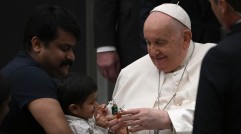Study: Dogs Indeed Get Jealous and Compete for Attention
A new study from the University of California, San Diego has confirmed something that many in America's pet-friendly society likely will consider nearly as obvious as the nose on a canine's face: dogs get jealous.
Researchers who dug up the new data note Charles Darwin -- the famed English naturalist considered the father of evolutionary theory -- believed dogs are prone to feeling green, but others who studied emotion argued complex cognition is necessary in order to feel jealous.
Still others suggested jealousy is a product of social interaction that, in fact, has not been observed in all human cultures and is not a basic emotion in the same ways fear and anger are.
But the new findings, published in the journal PLOS ONE by UCSD psychology professor Christine Harris and Caroline Prouvost, a former honors student at the school, asserts there may be a more basic form of jealousy that evolved to protect social bonds from interlopers, or outsiders.
The work shows that dogs exhibit more behaviors associated with jealousy, such as snapping and pushing at their owner or the rival, when the owner showed affection to what appeared to be another dog -- which, for the study, was in fact, a stuffed dog that barked, whined and wagged its tail.
"Our study suggests not only that dogs do engage in what appear to be jealous behaviors but also that they were seeking to break up the connection between the owner and a seeming rival," Harris said in a news release. "We can't really speak to the dogs' subjective experiences, of course, but it looks as though they were motivated to protect an important social relationship."
Since there had not been any previous experiments conducted to test the possibility dogs felt and acted on feelings of jealousy, Harris and Prouvost adapted a test model used with 6-month-old human infants.
The team observed 36 dogs in their own homes, recording video of the animals' reactions as their owners ignoring them in favor of a stuffed, animated dog, as well as a jack-o-lantern pail.
In both instances, the owners were told to treat the objects as though they were real dogs.
The dog owners were further instructed for a third scenario to read out loud a pop-up book that played melodies.
With two independent raters coding the videos for a variety of aggressive, disruptive and attention-seeking behaviors, it was discovered the canines were twice as likely to push or touch their owners when the latter were interacting with the fake dog, 78 percent of the time, as compared with the instances were showing attention to the pail, which elicited responses 42 percent of the time, or reading, which prompted attention-seeking responses about 22 percent of the time.
About 30 percent of the dogs in the study tried to insert themselves between their owners and the stuffed animal, while 25 percent snapped at the "other dog."
Only one of the four-legged study subjects snapped at the pail and book.
Harris and Prouvost concluded the apparent signs of aggression was proof the real dogs considered the stuffed pooch a rival -- which sparked feelings of jealousy.
The researchers included in their paper that 86 percent of the studied dogs sniffed the toy dog's rear either during or after the testing phase of the study.
Understanding the emotional process of jealousy is important, the researchers said, because it can cause far-reaching psychological and social consequences.
With the first signs of human jealousy demonstrated in babies and young children, the study said, there's ample reason to suspect the emotion may have evolved with siblings competing for parental resources and that people are indeed naturally inclined toward such feelings.
And it that's the case, even though "many people have assumed that jealousy is a social construction of human beings, or that it's an emotion specifically tied to sexual and romantic relationships," Harris said, the latest results show that "animals besides ourselves display strong distress whenever a rival usurps a loved one's affection."
Subscribe to Latin Post!
Sign up for our free newsletter for the Latest coverage!
* This is a contributed article and this content does not necessarily represent the views of latinpost.com














